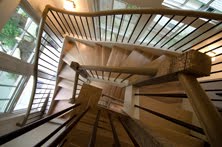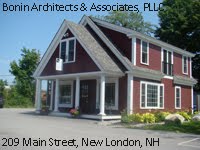 The September 2008 Special Green Building Issue features an interview with NH Architect Jeremy Bonin on energy efficient home design, sustainability, and timber framing.
The September 2008 Special Green Building Issue features an interview with NH Architect Jeremy Bonin on energy efficient home design, sustainability, and timber framing.Writer Peter Lobred asks Jeremy Bonin, a LEED accredited architect and the author of the timber frame book, TIMBER FRAMES: Designing Your Custom Home, pointed questions about building a timber frame home and incorporating sustainable design. After explaining some of the catch phrases in the green building industry, Jeremy answers questions such as “What are some basic considerations – or the most crucial elements – that consumers / architects can incorporate into their plans for sustainable design?” and “Does there seem to be a natural fit between timber frame homes and green considerations?”
Asked about the cost versus benefits of energy efficient home design and sustainable options, Jeremy reminds homeowners that the simplest solutions are not only the most cost effective and usually provide the largest return on investment. For example, designing the home for passive solar heating and daylighting adds no cost to the home and offers huge savings; using an energy-efficient insulation system such as Structural Insulated Panels (SIPs) to keep heat in and cold air out and only designing as much house as you need means lower energy bills for years to come.
If you’re building a green home, whether it’s timber frame, post and beam, structural insulated panels, or another energy efficient building system, energy efficient home design starts with the site selection and site design. Jeremy suggests consulting with an architect in the earliest possible stage, even prior to purchasing your land, and discussing your ideas and green materials you want to incorporate.
Read the full article, Simply Green.
Jackie Lampiasi, Bonin Architects & Associates




















